The Apollo 16 ‘C-
Of all the Apollo images, 3 attract the most attention from hoax loons: Apollo 8’s Earthrise, the Buzz Aldrin ‘visor’ shot, and one particular photograph form Apollo 16: AS16-
Here it is:
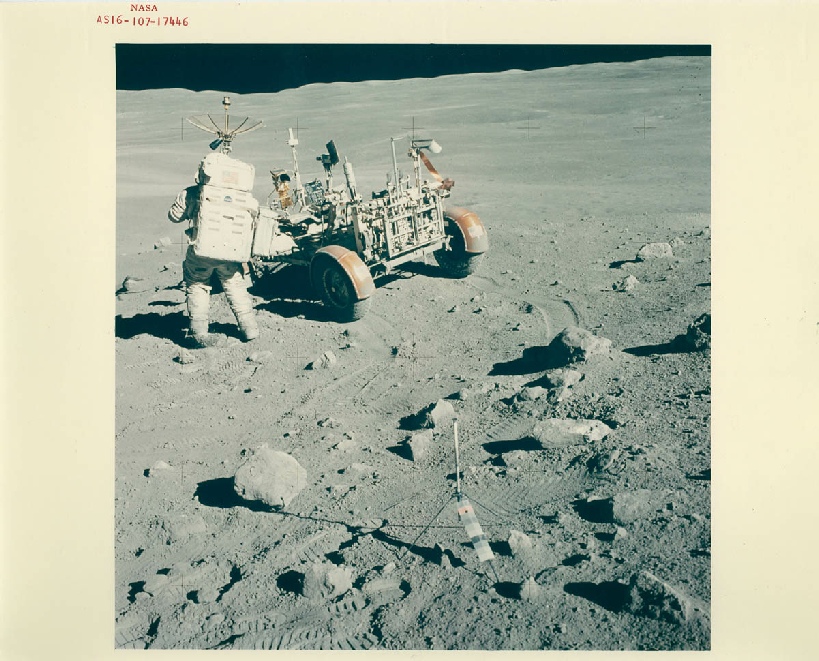
What they’re getting all excited about is an apparent letter ‘C’ on the large rock in the foreground.
‘Ooh’, cry the hoax crowd, “it’s a letter C, so it must be a fake rock on a fake moon set and that’s how they make sure that they always get that rock in the same place”.
It’s bullshit, of course. No set designer in their right mind would use such a system of set dressing when there are hundreds of rocks to put in place.
Many articles have already been written on the subject, including this excellent debunk from Paolo Atavissimo. An unlikely source of support for it not being a man made feature (at least in the sense that the hoaxtards mean) comes from (amongst others) Mike Bara, notorious grifter in the world of “aliens are already on the moon” conspiracy theories.
In order for him to be able to claim there are aliens in Apollo photographs on the moon, the missions need to be genuine, so he set about looking at the photo for his (now defunct) ‘lunar anomalies’ page.
His conclusion, after working with the Lunar and Planetary Institute and Johnson Space Center, was that it appeared a a result of re-
Enter Jarrah White, who managed to find an original wire image of the photo dated August 1st 1972. His conclusion from all this is that the ‘C’ was always there, and is definitely some sort of set dressing blooper. Any copies of the photo that don’t show the image are obviously airbrushed versions of the one true photo which somehow NASA were too stupid to stop going into print all over the place.
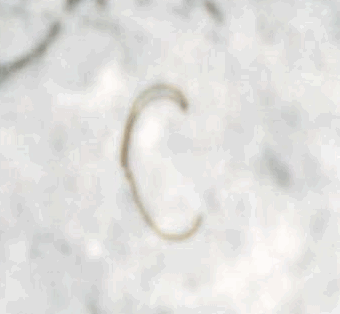
The purpose of this page isn’t to re-
This page merely attempts to gather together examples of the unblemished version from contemporary sources, and also to look at where that rock features in other Apollo images and broadcasts from the mission.
We’ll deal with that first, and to do that we’ll have some background.
The Apollo photograph was taken at Station 4 on the second EVA of the mission. Charles Duke and John Young drove their rover to the right of their eventual parking spot, before turning round and parking up. See here for the transcript of the drive. Below are annotated two maps from the ALSJ showing their route and the location of photographs taken on the way and during their sampling programme.
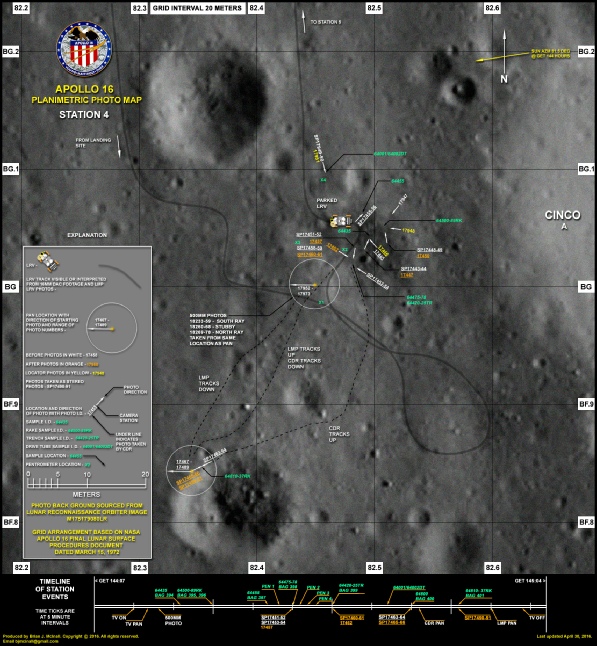
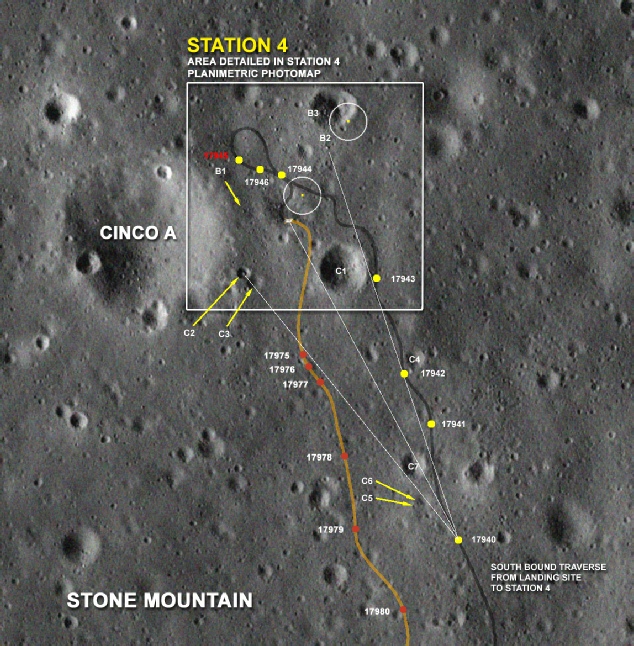
During the drive, magazine 110 was used to take photographs at regular intervals complementing the 16mm footage also being shot. One of the last photos taken before coming to a stop was AS16-
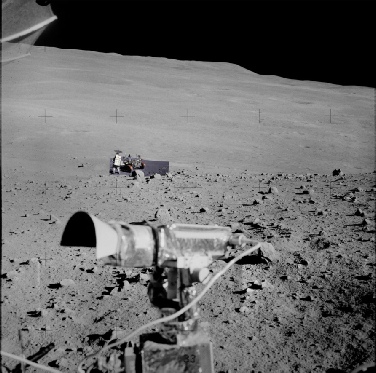
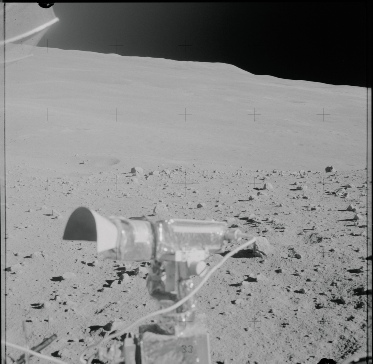
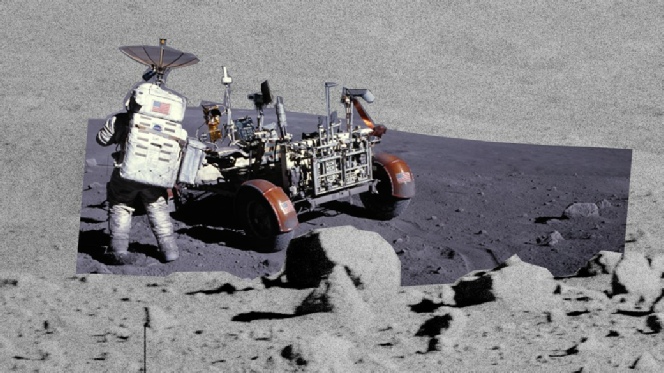
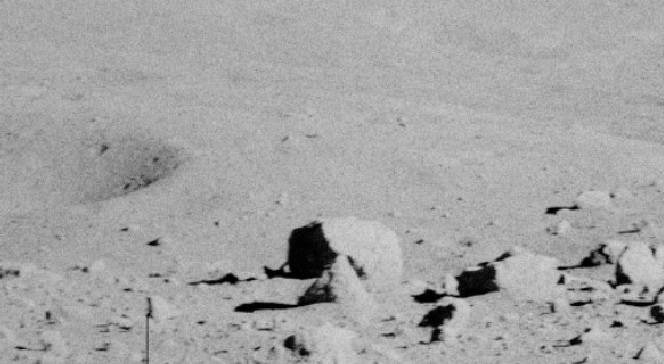
The C rock is behind the ridge in the foreground, but others in the photo are easy to identify. You can see how much the photo has had to be reduced to match. Pretty big film set, eh?
Another indication of how big the ‘set’ is can be seen from another magazine 110 photo taken below the LRV looking up towards where the original photo was taken.
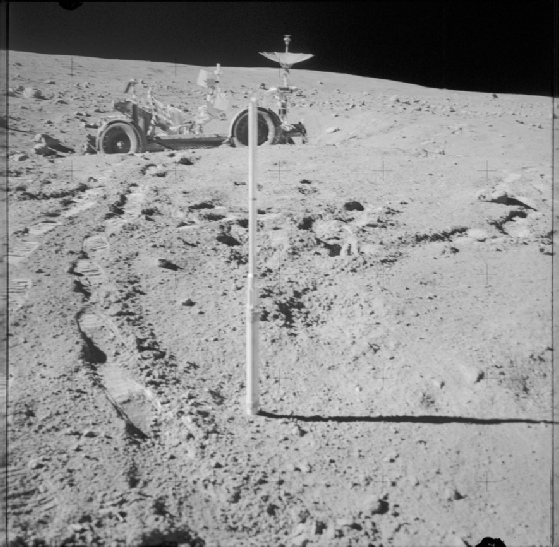
This photo, AS16-
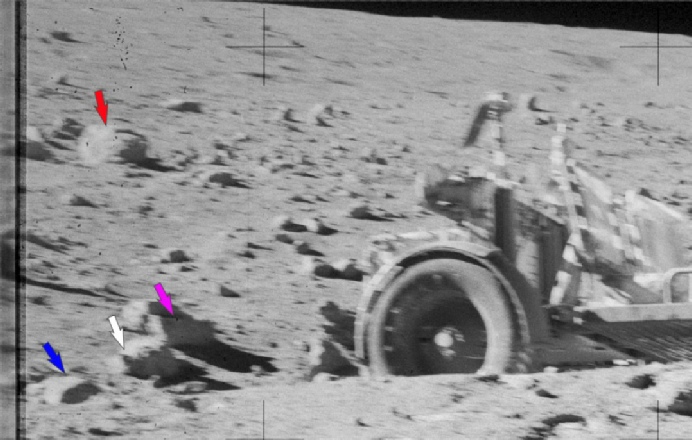
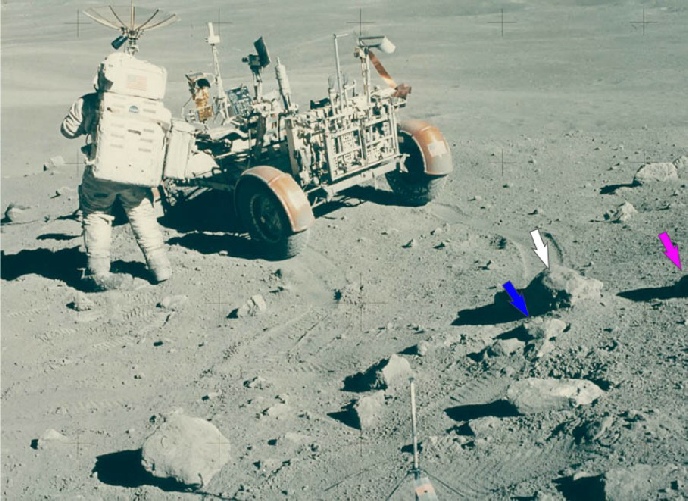
A few frames after the one above we have AS16-
So far we’ve managed to pick out photos where the C rock isn’t. What about ones where it is?
The most obvious one to start with is the photograph taken immediately before the C rock one, AS16-
This image has never shown any sign of the supposed letter C in any way, no matter the source.
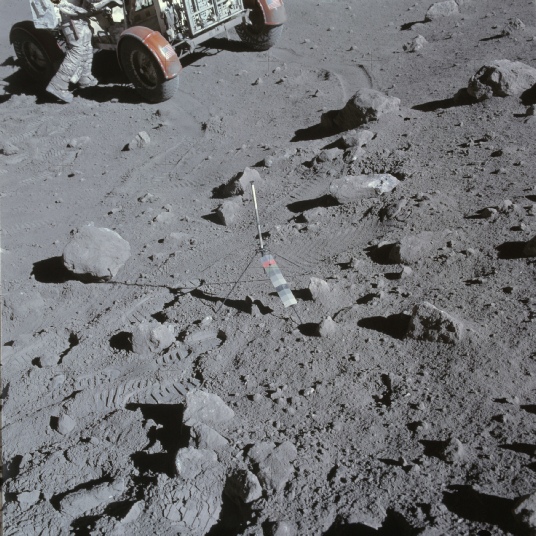
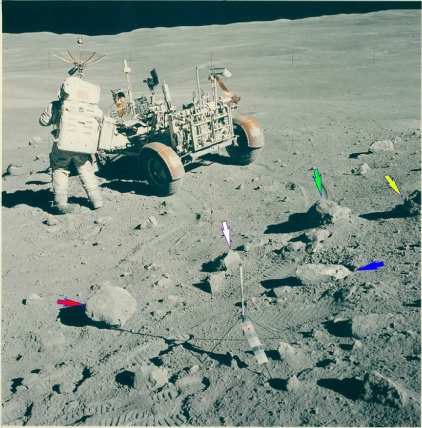
We can be certain it’s the same rock thanks to the white edging, and the arrows identify the same rocks in each photo so we can be certain. The darker bank running vertically down the rock is where there is a change in surface angle, and while it’s not exactly clear there’s no evidence whatsoever of any kind of lettering on the rock -
We have another few views of the C rock, taken from a variety of angles as the crew document their sampling duties. Here’s AS10-
Again, the rock is shown with the face that should have a letter ‘C’ clearly visible, and it equally clearly isn’t there.
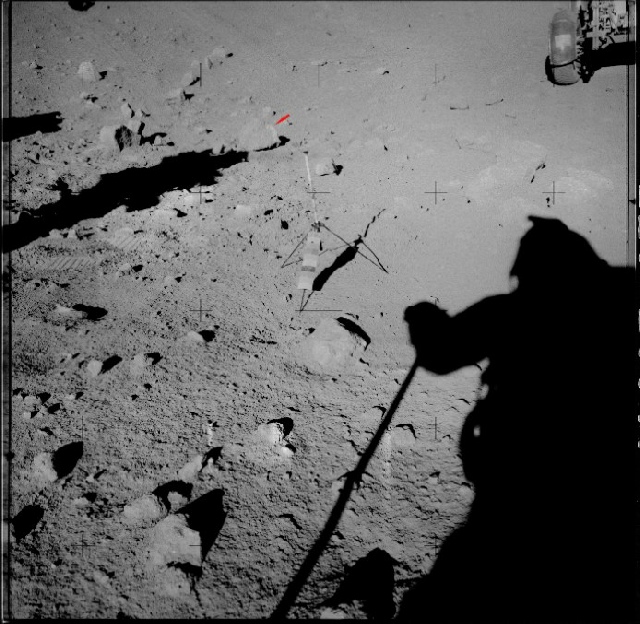
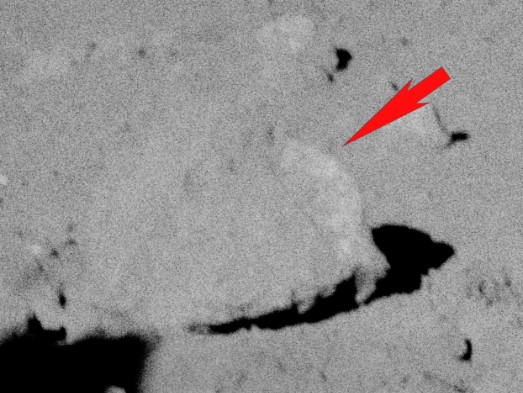
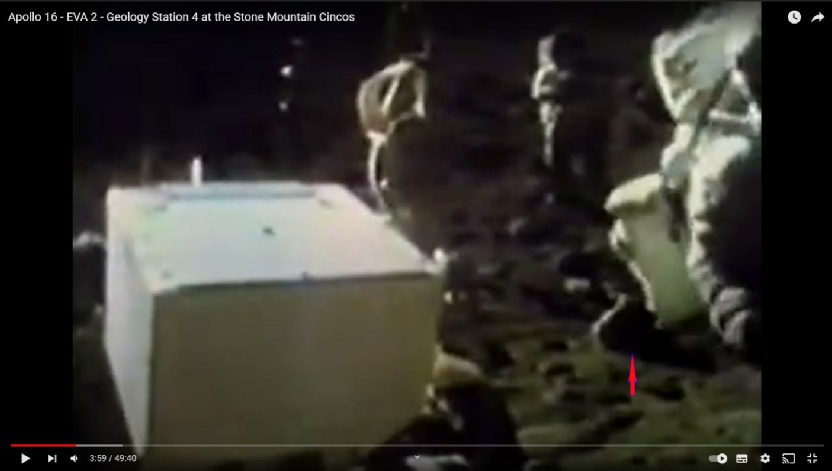
At the same time as the astronauts were going about their sampling duties they were being broadcast on live TV.
The still to the left shows the moment the photograph was taken (source), and the red arrow identifies our rock -
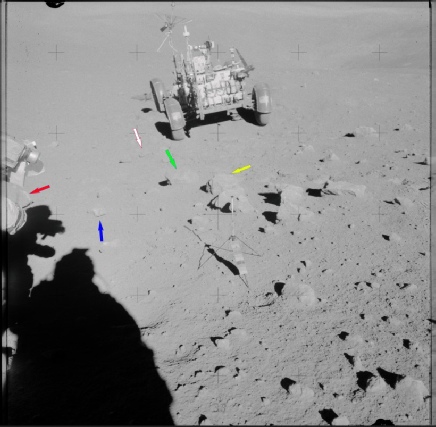
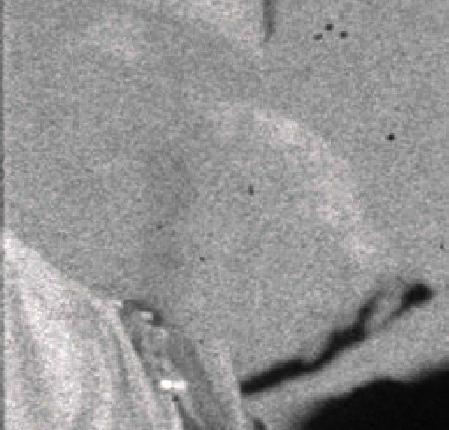
Shortly after documenting the sampling process, Charles Duke wanders off to one side to get a panorama of Station 4 -

Here’s one of the photos, AS16-
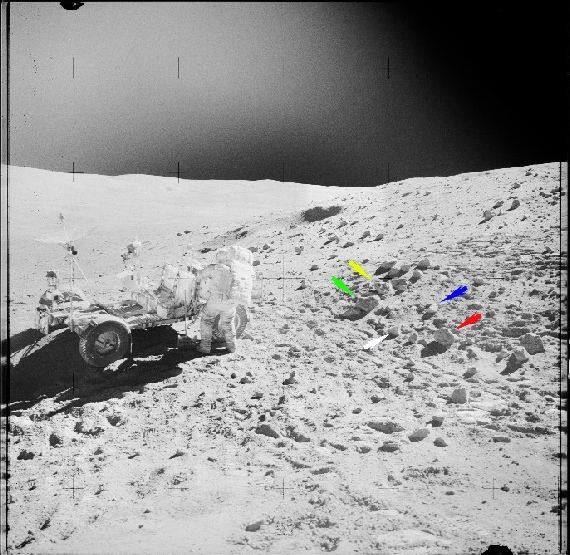
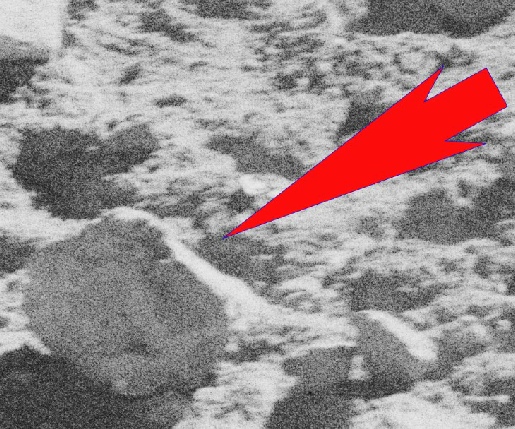
The size of the panorama, and the fact that all the features in it are photographed from other vantage points during their stop at Station 4, should again be a clue that this is not some sort of stage set, and there is no way one single letter of the alphabet is going to enable them to position all those rocks exactly.
Seeing as we’re going to be looking at contemporary versions of these images, it’s worth pointing out that some of the photos above, including the one taken before the C rock image, are included in the Apollo 16 Geology Report. The photos below are of my own personal copy.
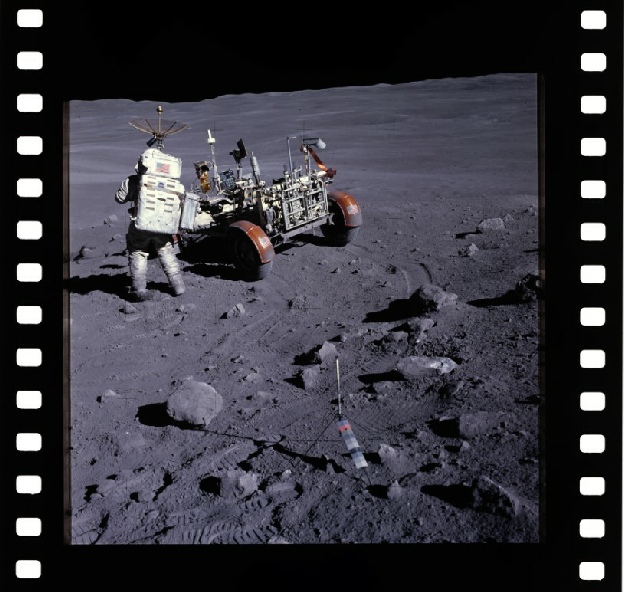
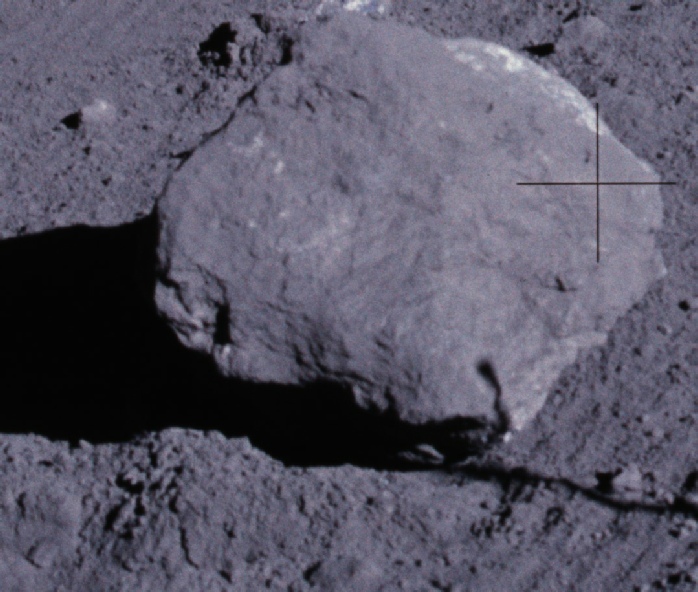
The high resolution scan also disposes of the claim that there is a second letter C on the ground next to the rock -
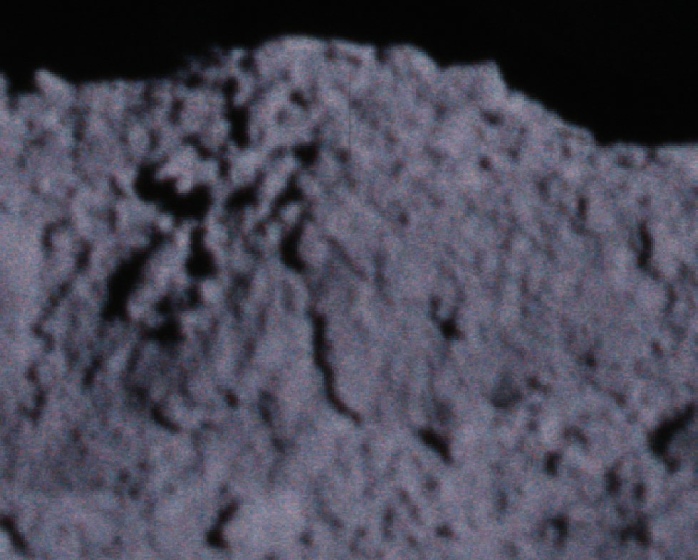
The most famous example of a completely absent C in the photo is the cover of Aviation Week & Space Technology (AWST), dated the 8th of May, a week after the May 1st press photo Jarrah now proudly owns. Here’s a scan of my hard copy of AWST.
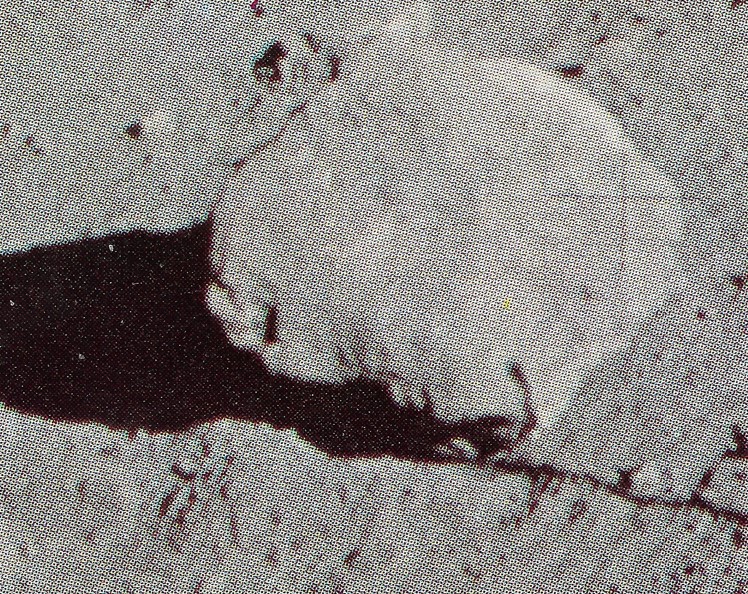
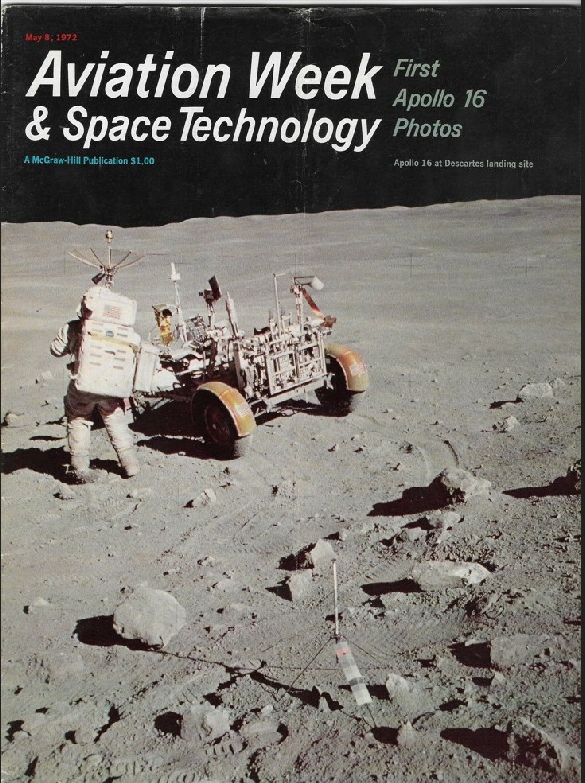
The May 8th edition will have received its copies of the photo from NASA at the same time as newspapers got theirs. Jarrah’s claim is that it is airbrushed out, when really the simplest explanation is that there were multiple print runs and not all of them showed the addition.
He needs to show where he airbrushing has occurred, who did it, and why NASA (evil geniuses that they are) somehow failed to prevent itself releasing those C rock images over and over again to anyone who asked for them.
Even if the C was airbrushed out, that still isn’t proof it wasn’t taken on the moon, just that someone spotted something that wasn’t on the rocks in view.
AWST isn’t the only source of the untarnished photo. The Preliminary Science Report also has it, as seen in this photo of my own copy (left)
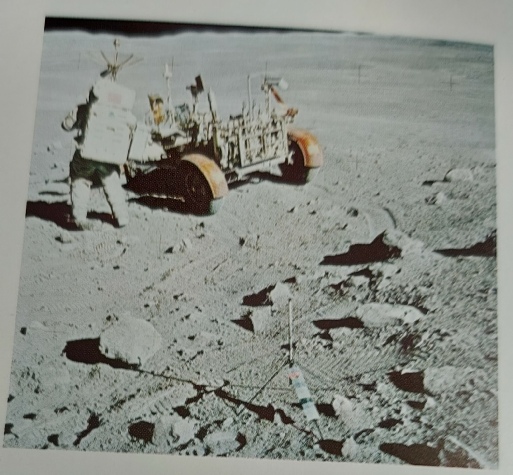
It’s also noticeably absent in the 1974 coffee table book “Man’s greatest adventure”, and again this is my own copy on the right.
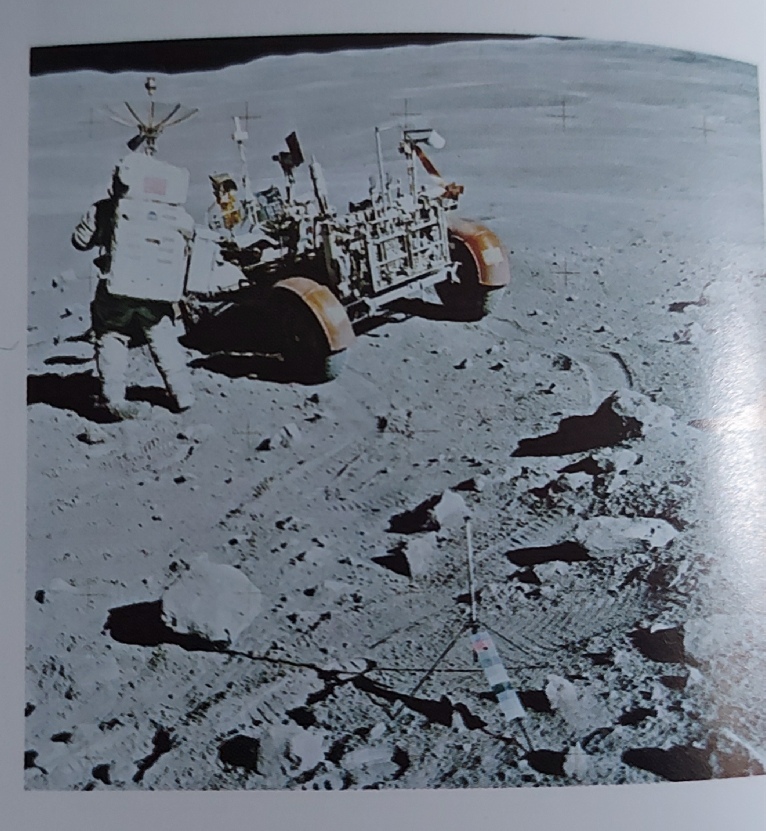
So those are the photos of Station 4 that show the C rock, only one of which shows the alleged letter C, what about the origin of the artefact in the photo?
Jarrah’s claim is that the C was “airbrushed out” of later copies released by NASA, despite highlighting himself many examples from after the mission where photos supplied by NASA clearly show it. He’s a little dishonest in his claim that the original lunar anomalies article has been deleted -
The first one we should probably look at is the scan of the positive taken by the Hasselblad at the March to the Moon website:
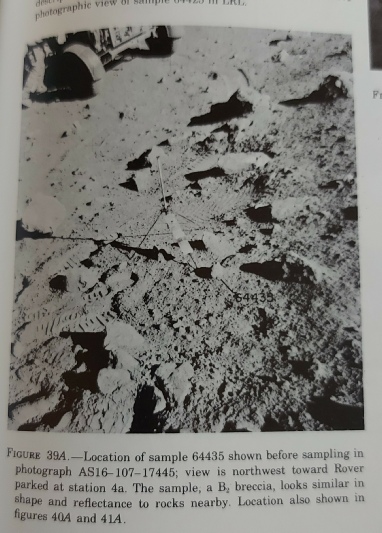
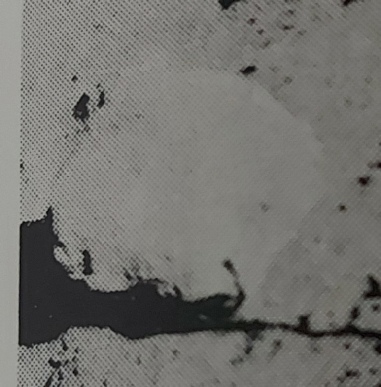
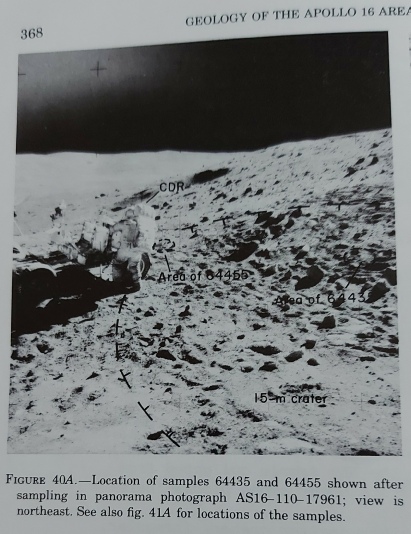
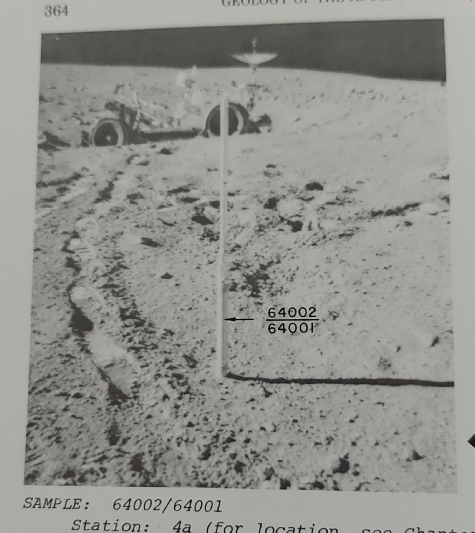
If you look closely, you’ll find no difference between these and later reproductions.
Or a letter C.
Transparencies were also a popular souvenir item for space enthusiasts, and numerous companies obtained copies form NASA to sell on. These These three different examples also show no sign of the letter ‘C’, and again they’re from my own collection.
That claim is made in David Percy and Mary Bennett’s “Dark Moon”, and it’s pretty obvious that the version they reproduced (seen here in my own copy of their work of fiction) has been deliberately and fraudulently enhanced. For these people to claim Apollo images have been airbrushed when they’re pulling this kind of stunt is a bit rich.
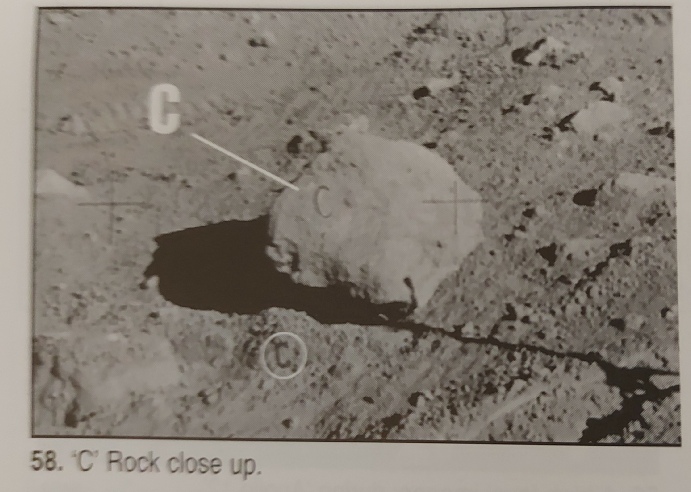
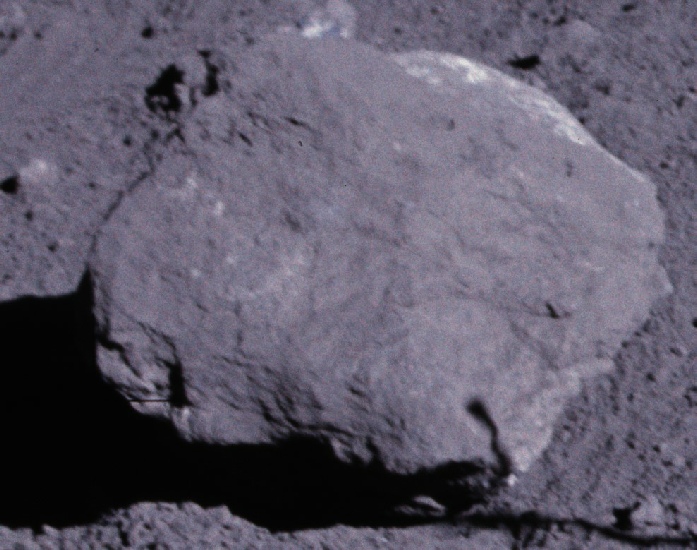
It’s worth comparing that close-
There is absolutely no difference between the two.
Not a single thing.
That’s quite the airbrushing skill to be able to do that.
So there we are.
Many photographs were sent out by NASA over a period of many years with a blemish that appears to be a letter C on it.
People with no critical thinking skills have decided that it means it’s a fake rock on a fake moon set.
It isn’t.
Many other versions of the photograph without the blemish exist. If you think they’re airbrushed, prove it. If they airbrushed it out of some versions, why continue to send out un-
That includes their own publications, like this ‘NASA Facts’ one (my copy), shown to the right.
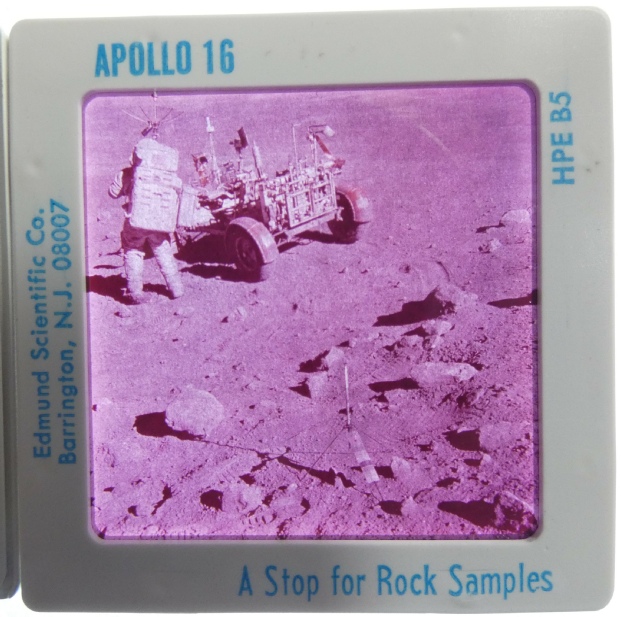
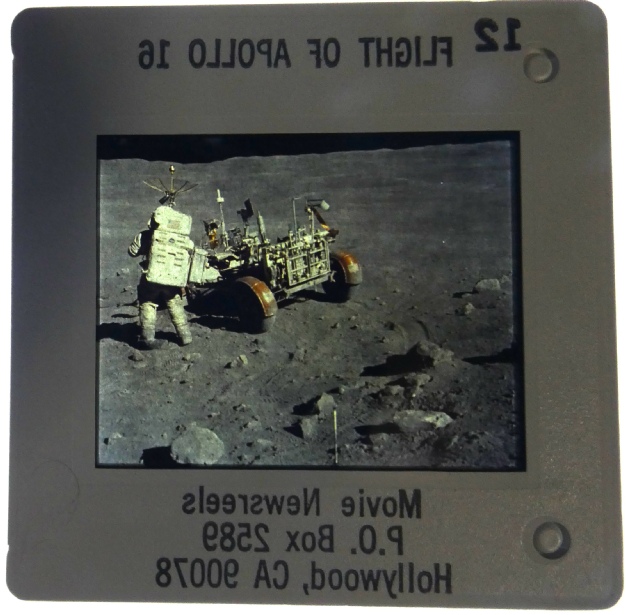
The simple reality is that, as described in this article, and in great detail in this one, the original positive film was photographed onto another film, an ‘internegative’. That internegative was itself duplicated many times, and from those duplicates printed copies were made by projecting onto photographic paper. One had a fibre on it, others did not. The fact that it does not appear to be on any other photographs suggests that the fibre was on one of the internegative duplicates, rather than on the equipment used to project them onto the paper.
There was no concerted effort to rid the internet of the defective version, they just did better scans of ones without it. Any claims that NASA have tried to purge their records to hide it are just a lie. Even if they did remove it, it doesn’t prove they weren’t taken on the moon, just hat someone took an editorial decision to remove an obvious falw.
It’s not a marker on a prop, it serves no purpose being there and no set designer in their right mind would use it. Some conspiracy idiots have deliberately added things to the photo to make it fit their narrative. That’s what dishonesty looks like, not anything they think NASA has or hasn’t done. The best that Jarrah can claim with his photo is that the ‘C’ was around before the LPI scanned them, which anyone could figure out if they had one of the originals from NASA.
Addendum:
Never ones to miss out on a free lunch, the ‘Apollo Detectives’ have weighed in on the argument, because, you know, that paypal account won’t fill itself now will it.
It doesn’t start well -
Er…no Marcus, he got it off eBay.
He quite clearly says that’s where he got it -

Nothing to do with “Jarrah’s persistence”, as they claim, everything to do with him just seeing it on eBay (Jarrah never claimed otherwise). Jesus they’re fumb.
That’s how good at detecting they are. Remember that if ever you are tempted to believe any of the garbage they spout.
There then follows a lot of bluster and nonsense about NASA desperately trying to debunk the image (nah, they really didn’t bother) and about how they are so well informed about stuff (I nearly had coffee all over my monitor for that one) before they get on with looking at the image all by themselves.
The funniest bit is where they actually concede that it does look like a hair follicle, but that it presents a problem because the astronaut was wearing a space suit, so it couldn’t be from him.
“I mean it it does look kind of like [a hair follicle] well it it may well be why would they get to such trouble well you see this is what I don't understand if they say that this is the original we have a problem because you can't have hair falling out on an astronaut that has a space suit on and a helmet on so how did that hair get there?”
How big would that hair follicle need to be if it was from an astronaut, you dumb fucks? No-
They then talk about how a hair follicle could have got n the equipment during the internegative reproduction (though don’t use the fancy words), before concluding that they did not send Jarrah an original from the vault.
How rude, fancy not just opening up the vaults and sending some chancer an original image. How stupid do you have to be to watch Jarrah’s video, reproduce his article, actually show the eBay page and still think he wrote to NASA?
Then having actually, completely by accident, hit upon the genuine explanation, Allen immediately wades in to regurgitate the utterly idiotic idea that it’s a studio set prop.
There then follows a claim that the rock has been “overturned by the rover” -
"Up on some of the blocks, yeah. If I remember, they were more subdued blocks, though. I mean, it wasn't a boulder sticking up a meter, but the width and breadth of the block was a meter. It wasn't any problem. That car just really moved over all that kind of surface. I think we were probably ten or twelve inches off the surface -
There’s then all sorts of nonsense about how the rover was craned in and out and tyre tracks and other utter made up strawman nonsense, these people have no idea how wheels work.
Everything in the video is just a mish mash of utter fabrication, ignorance, personal incredulity, strawman and ‘if I ran the zoo’ fallacies -
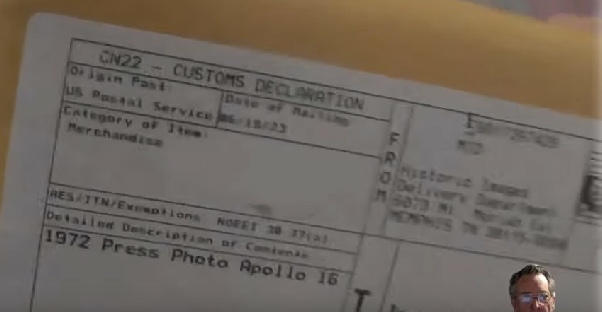
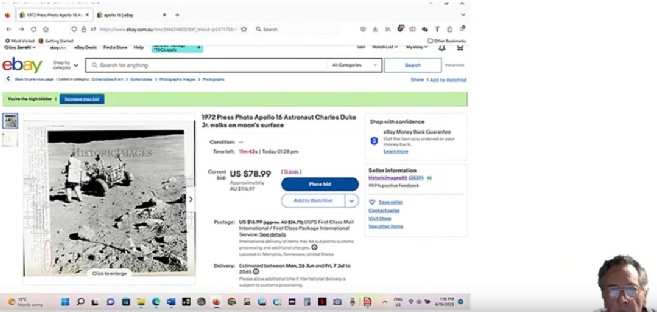
They claim that no-
These people are just ignorant grifters. They know nothing, they do no detective work, they just regurgitate utter stupidity that has been debunked many many times over, and the morons that follow them lap it up. The only good thing about the video is the clip of convicted criminal and arch grifter Bart Sibrel getting a well-
Do your own detective work, don’t fall for their lies, and certainly don’t hand over any money to them.
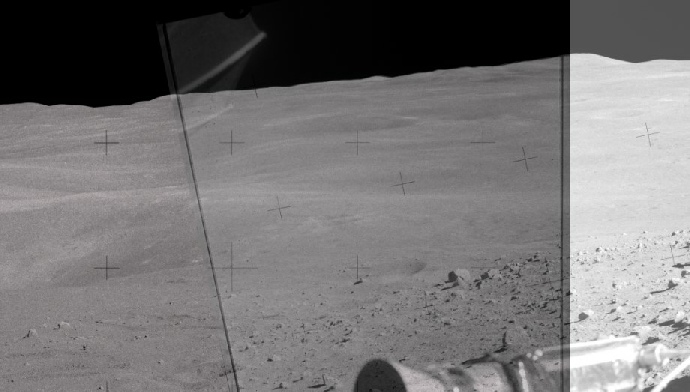
The background image claim is just flat out wrong -
On the right are two photos taken above Station 4 aligned on the hills in the distance -

There are even original ‘red number’ prints without the C, as sourced here.

No letter C in those.
